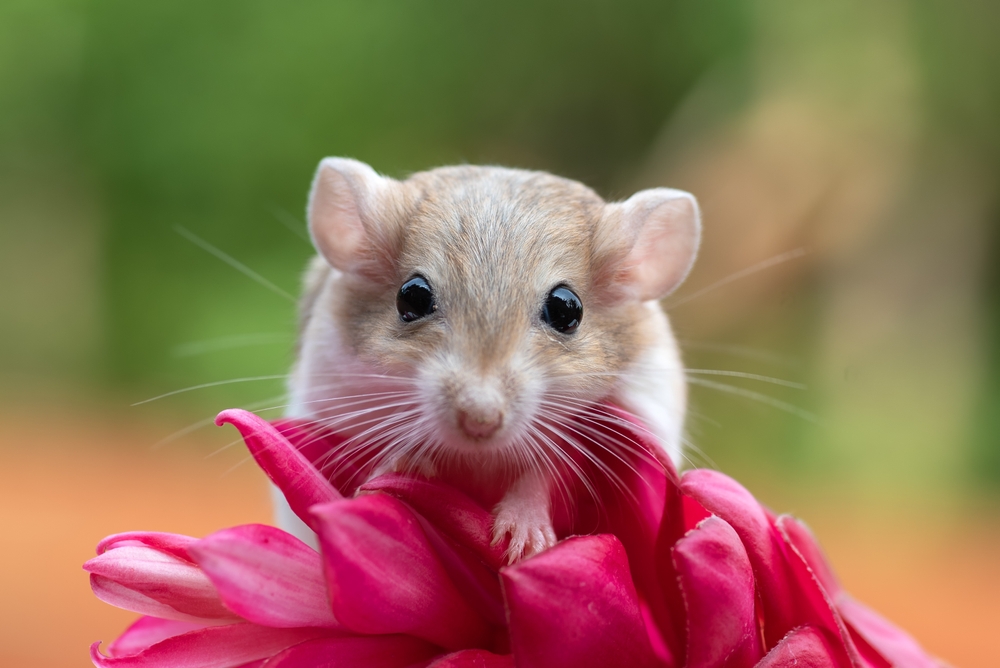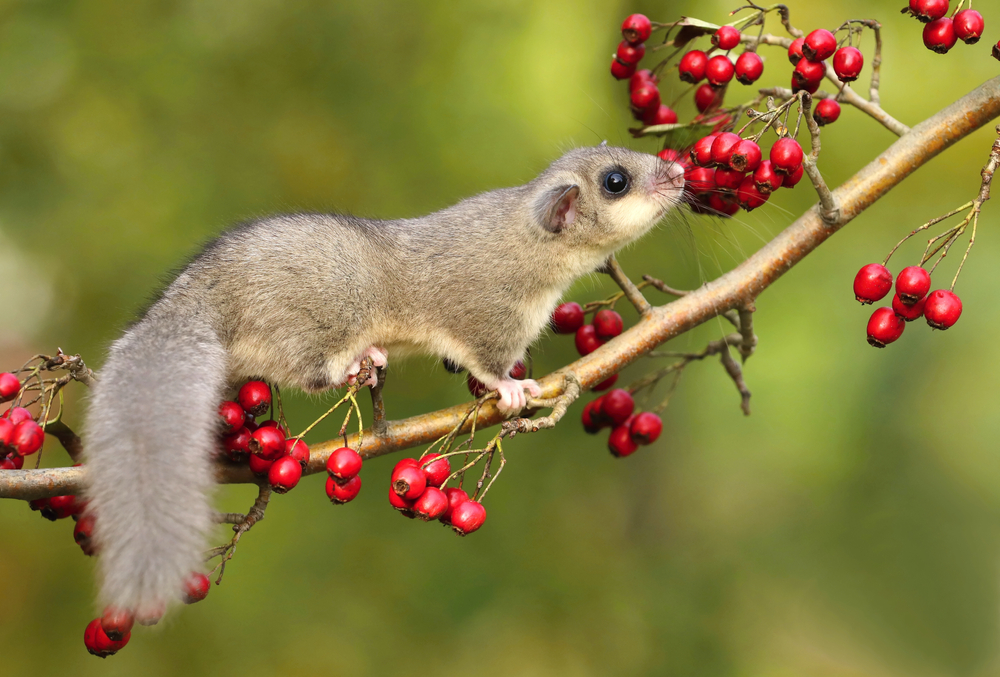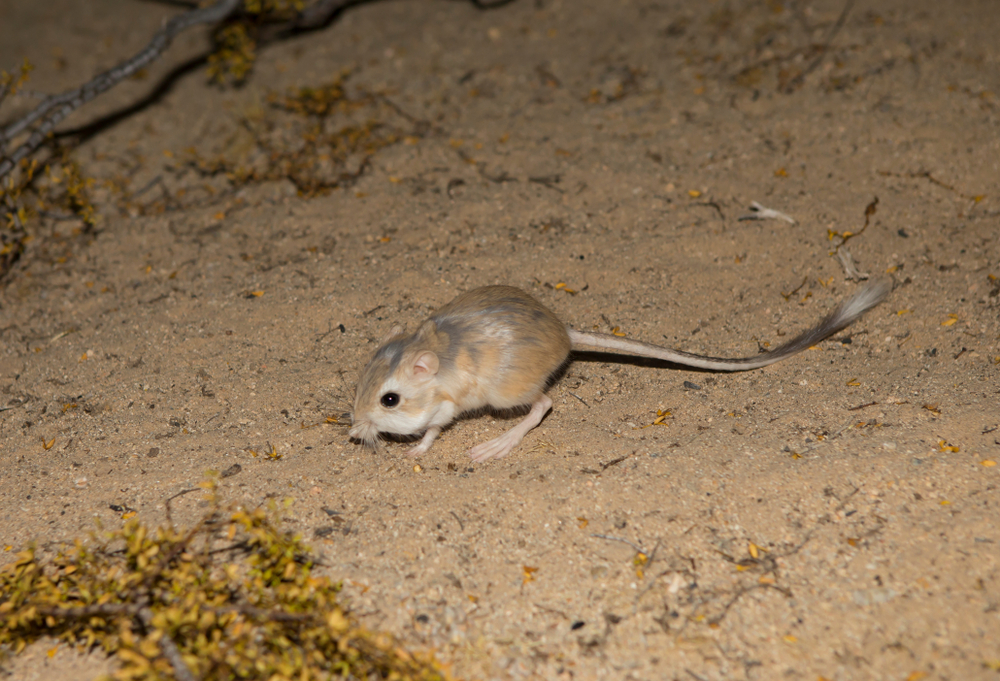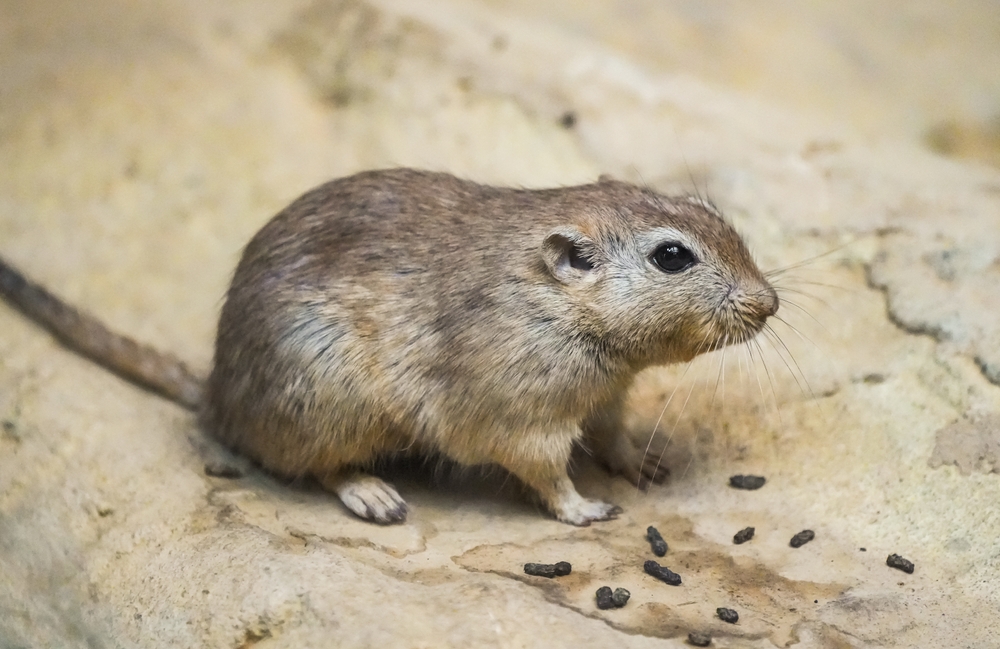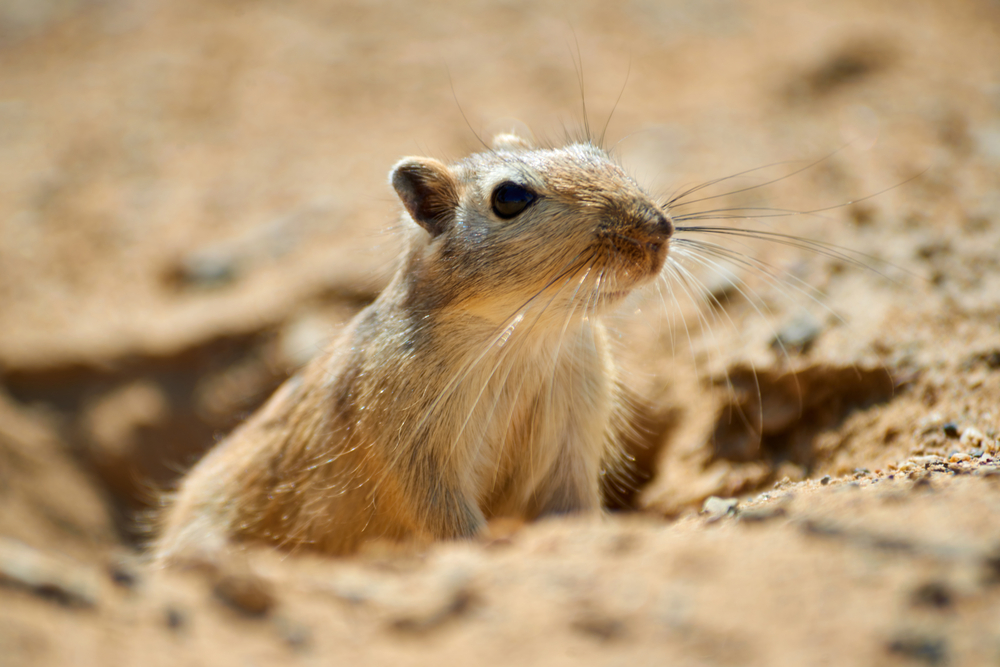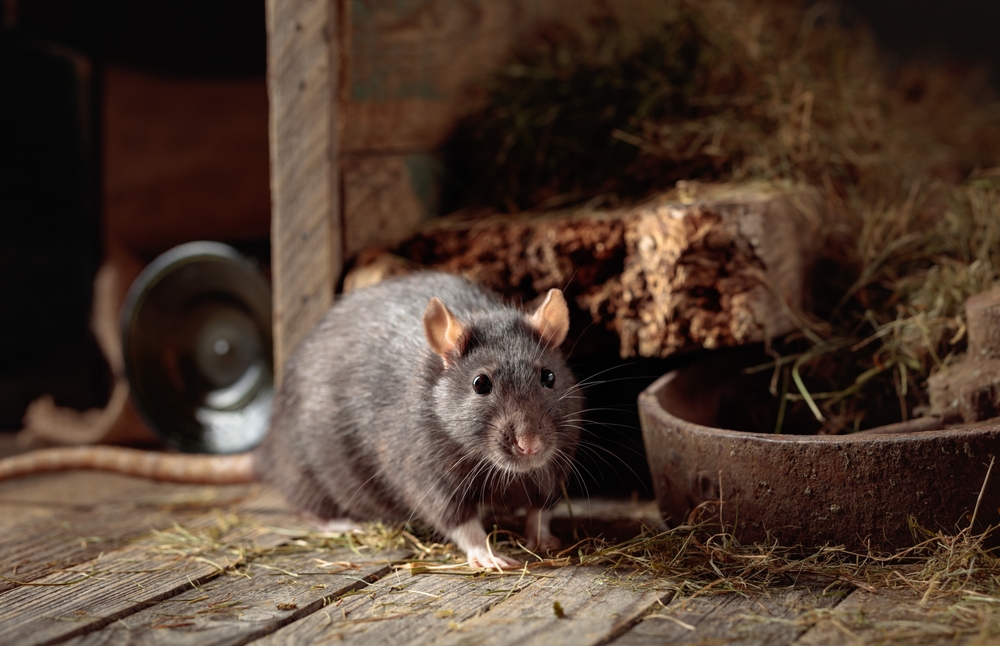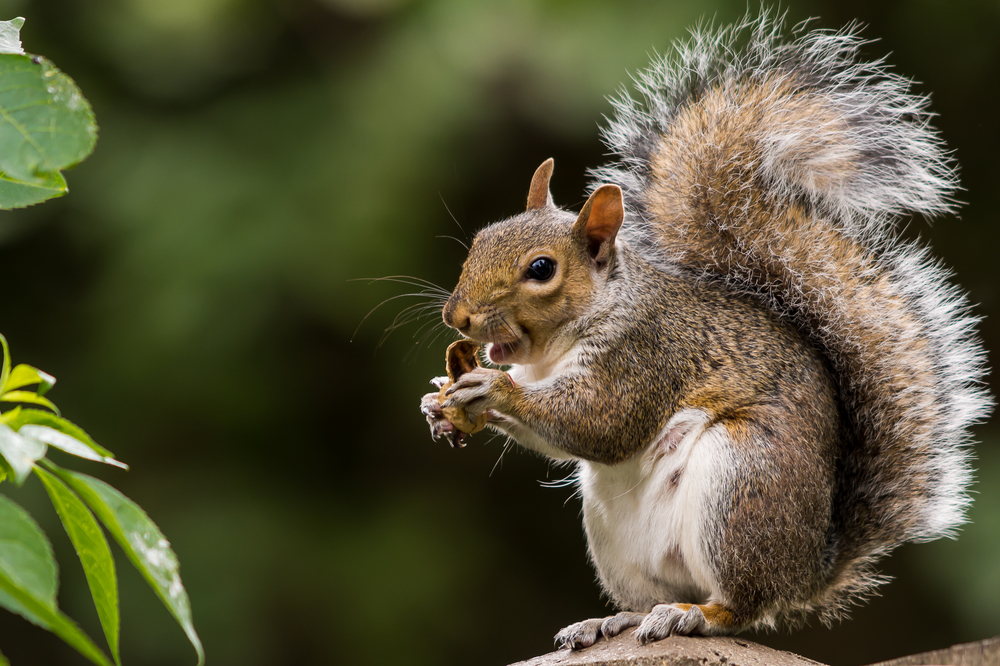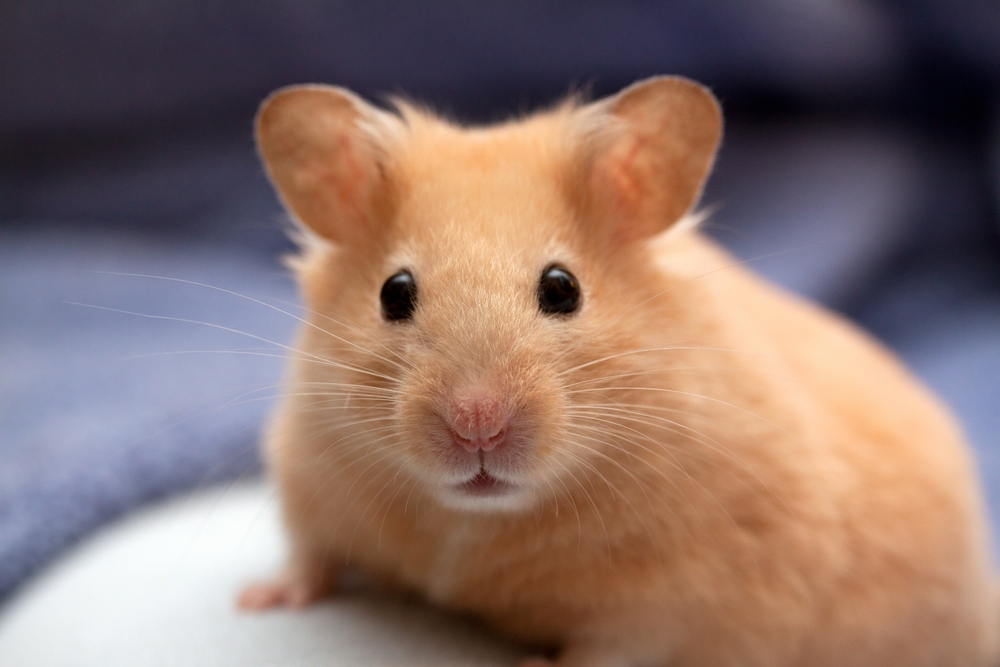The closest relative is the Pallid Gerbil (Gerbillus perpallidus), which shares similar body proportions, burrowing habits, and dietary flexibility. However, the Pallid Gerbil is smaller, lighter in color, and adapted to more arid desert conditions, whereas the Mongolian Gerbil thrives in semi-arid steppe and grassland habitats.
About
The Mongolian Gerbil is a hardy, social rodent native to the semi-arid steppes and deserts of Mongolia and northern China, with wild populations also extending into Russia. Belonging to the family Muridae, it is best known worldwide as a popular small pet, though it thrives equally well in its natural habitat.
Adult Mongolian Gerbils measure 20–25 cm (8–10 in) in total length, including a long, furry tail tipped with a tuft of hair, and weigh 60–130 g (2–4.5 oz). Their fur is typically sandy-brown with a lighter underside, providing camouflage in their dry, grassy environments. They have large, dark eyes and long hind legs, which allow for quick, bounding movements when escaping predators.
In the wild, Mongolian Gerbils live in complex burrow systems that protect them from temperature extremes and predators such as snakes, owls, and foxes. These burrows house social groups consisting of a dominant breeding pair and their offspring, and they include nesting areas, food storage chambers, and multiple entrances for quick escape.
Their diet consists mainly of seeds, roots, grasses, and insects, with food caching being an important survival strategy. They are active during the day (diurnal) and spend much of their time foraging and maintaining their burrows.
Mongolian Gerbils are noted for their intelligence, curiosity, and social nature, which has made them popular as low-maintenance companion animals. In captivity, they require ample space for digging, chewing, and social interaction to mimic their natural behavior.
The Mongolian Gerbil’s scientific name is Meriones unguiculatus, and it belongs to the family Muridae.
Physical Characteristics
Fur and Coloration:
The Mongolian Gerbil has soft, dense fur that is typically agouti (brownish-golden with black-tipped hairs), blending with its natural steppe and desert surroundings. The underparts, including the belly and inner limbs, are white or cream. Domesticated populations exhibit a wide variety of coat colors, including black, white, gray, lilac, and spotted patterns.
Head and Eyes:
The head is medium-sized with a gently tapered muzzle. Large, dark eyes provide good vision in dim light, and the ears are small, rounded, and sparsely furred to minimize heat loss and sand intrusion.
Body:
The body is slender yet sturdy, built for both running and digging. Their streamlined form allows quick movement above ground while still being powerful enough for burrow excavation.
Legs and Feet:
-
Hind Legs: Longer and more muscular than forelegs, adapted for bounding movement but not fully bipedal hopping.
-
Forelegs: Strong, with sharp claws for digging tunnels.
-
Soles are covered with fine fur to protect against hot or cold ground.
Tail:
Long—about the same length as the body—and covered in fur with a distinct tuft at the tip. The tail aids in balance while running and serves as a visual signal in social interactions.
Size:
-
Body Length: 11–13 cm (4.3–5.1 in)
-
Tail Length: 9–12 cm (3.5–4.7 in)
-
Weight: 60–130 g (2.1–4.6 oz)
Sexual Dimorphism:
Minimal; males and females are similar in coloration and size, though males may have slightly broader heads and heavier bodies.
The Mongolian Gerbil’s balanced body build, sandy camouflage, and long, tufted tail make it a fast, efficient burrow dweller in the grasslands and deserts of Central and East Asia.
Reproduction
Mating Behavior:
Mongolian Gerbils are monogamous in the wild, often forming lifelong breeding pairs. Courtship includes mutual grooming, scent marking, and brief chases. Established pairs show strong pair bonds and cooperative parenting.
Breeding Season:
In the wild, breeding generally occurs from spring through late summer (March to September) when food is most abundant. In captivity or under favorable conditions, they can breed year-round.
Gestation and Litter Size:
-
Gestation Period: About 24–26 days.
-
Litter Size: Typically 4–6 pups, but can range from 1 to 8.
-
Females can have up to 5–6 litters per year in optimal conditions.
Nesting:
Birth occurs in underground burrows with nesting chambers lined with grasses, plant fibers, and fur. Burrows are well-insulated, protecting pups from temperature extremes and predators.
Young:
-
Appearance at Birth: Pink, blind, and hairless.
-
Weaning Age: Around 3–4 weeks.
-
Both parents participate in feeding, grooming, and protecting the young.
Maturity:
Juveniles reach sexual maturity at 2–3 months of age, allowing rapid population growth during favorable seasons.
The Mongolian Gerbil’s monogamous pairing, cooperative parenting, and ability to breed multiple times per yearcontribute to its success in harsh steppe and desert environments.
Lifespan
Lifespan in the Wild:
In natural steppe and desert environments, Mongolian Gerbils typically live 1 to 2 years, with high predation and harsh weather limiting survival.
Lifespan in Captivity:
With stable food supplies, predator protection, and veterinary care, they can live significantly longer.
-
Average Maximum Lifespan: 3 to 5 years in managed care, with some reaching 6 years under ideal conditions.
Threats to Longevity:
-
Predation: Vulnerable to raptors, snakes, foxes, and small carnivores.
-
Climate Extremes: Severe cold in winter and heat in summer can stress populations.
-
Food Scarcity: Harsh winters or droughts reduce plant and seed availability.
-
Human Activity: Habitat loss from agriculture and trapping for the pet trade in some areas.
Adaptations for Longevity:
-
Social Burrows: Live in cooperative family groups that share predator vigilance and burrow maintenance.
-
Food Caching: Store seeds and plant material for use in winter and during drought.
-
Efficient Water Use: Obtain most water from food, minimizing the need to drink.
The Mongolian Gerbil’s social cooperation, food storage habits, and adaptability help sustain populations even in extreme and fluctuating environments.
Eating Habits
Diet:
Mongolian Gerbils are omnivorous foragers with a diet dominated by plant materials.
-
Primary Foods: Seeds, grains, grasses, roots, and bulbs from steppe and desert plants.
-
Seasonal Variation: In spring and summer, they consume more fresh green vegetation; in autumn and winter, they rely heavily on stored seeds and roots.
-
Occasional Foods: Insects and larvae, especially during breeding season when protein demands are higher.
Water Acquisition:
-
Obtain most of their water from food, especially fresh plants.
-
Efficient kidneys conserve water, allowing survival without frequent drinking.
Feeding Behavior:
-
Forage both near burrow entrances and at greater distances, often following established paths.
-
Use cheek pouches to transport seeds and plant material back to underground storage chambers.
-
Engage in food caching to ensure winter survival.
Foraging Strategy:
-
Exploit a variety of plant species to adapt to seasonal changes in vegetation.
-
Will dig for underground plant parts during dry seasons.
-
Feed mainly during cooler times of day to avoid heat stress and reduce predation risk.
Adaptations for Feeding:
-
Strong forelegs and claws for digging up roots and bulbs.
-
Cooperative foraging within family groups, which increases efficiency and safety.
-
Flexible diet allows survival even when preferred foods are scarce.
The Mongolian Gerbil’s varied diet, food caching behavior, and efficient water use make it highly resilient to the unpredictable conditions of its native habitats.
Uniqueness
Monogamous Family Groups:
Unlike many small rodents, Mongolian Gerbils form lifelong breeding pairs and raise young cooperatively, with both parents participating in care and defense.
Complex Social Burrows:
Construct multi-chamber burrow systems with nesting rooms, food storage chambers, and multiple entrances for predator escape.
Efficient Water Conservation:
Capable of surviving on minimal free water by extracting moisture from food and producing highly concentrated urine.
Food Caching Specialists:
Store seeds and plant material underground for winter and drought survival, ensuring year-round access to food.
Wide Color Variation in Captivity:
While wild gerbils are agouti-colored for camouflage, domesticated populations display a wide range of coat colors and patterns due to selective breeding.
Adaptability to Harsh Environments:
Native to Mongolia, northern China, and Siberia, they are well adapted to extreme seasonal changes, from freezing winters to hot, dry summers.
The Mongolian Gerbil’s social structure, cooperative parenting, and burrow engineering skills make it one of the most intelligent and behaviorally complex small rodents in the world.
Be the First to Share Photos of This Species.
FAQ’s
1. What is the closest species to the Mongolian Gerbil?
2. How does the Mongolian Gerbil compare to other rodents?
The Mongolian Gerbil varies from other rodents in a number of ways:
-
Social Structure: Unlike many solitary rodents, it forms lifelong breeding pairs and cooperative family groups.
-
Burrow Systems: Builds multi-chamber burrows with dedicated food storage areas, more complex than those of many similar-sized rodents.
-
Diet Flexibility: Can switch between fresh vegetation, seeds, and insects depending on season.
-
Water Efficiency: Survives on minimal free water, similar to desert rodents like kangaroo rats, but in a broader range of climates.
-
Domestication: Commonly bred as a pet, unlike most wild gerbil species.
3. What national parks provide the best chances to see a Mongolian Gerbil?
Mongolian Gerbils inhabit steppe and semi-desert regions of Central and East Asia. Likely viewing locations include:
-
Gobi Gurvansaikhan National Park (Mongolia)
-
Hustai National Park (Mongolia)
-
Khar Us Nuur National Park (Mongolia)
-
Gobi B National Park (Mongolia)
-
Daursky Nature Reserve (Russia)
They are most often spotted near burrow entrances during early morning and evening.



































































